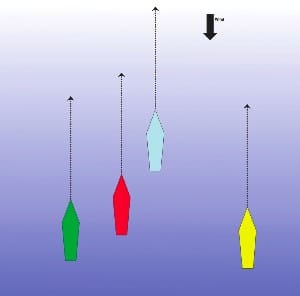To the editor: Extra scope and chafe protection are crucial when a gale blows through. Two or three anchors are needed when a hurricane approaches. But calm weather — far more common than storms — can create some of the most challenging anchoring situations.
We’d been anchored for two weeks in Wreck Bay on San Cristóbal Island in the Galápagos when the 36 boats of a round-the-world rally began arriving. Added to the 20 boats already anchored in the bay, it made for a bit of a crowd.
Complicating the situation was poor water clarity due to run-off from a day of strong rain. Usually we could see our anchor in 30 feet, as well as the various rocks and sandy spots. There was also a complete absence of wind. The bows of the anchored boats pointed in every cardinal of the compass.
Calm weather may mean the only change to your anchoring technique is to add a few more RPMs when backing down as you don’t have the additional force of the wind to help check the set. But when other boats are involved, be aware that you can’t trust the spot you pick until the wind returns. Here’s why.
When a boat drifts willy-nilly with current and zephyrs, the anchor chain will not be stretched out in straight line on the bottom. The weight of the chain itself — not the anchor — is holding the boat in place. The chain could be in the form of an S, a large U, a loop, or any combination. The boat could be sitting directly on top of the anchor with the chain crisscrossing itself to port, starboard, ahead or astern.
It’s natural to pick a spot with plenty of space between the anchored boats and then drop the hook so that, after backing down, you are lying in your chosen location. The problem is that your chain is now, most likely, the only one lying straight along the bottom. When the wind picks up and begins to unravel those curves and loops, boats that were far away suddenly seem very close. You might even think they are dragging while your hook is well-set. But actually their anchors haven’t moved an inch; they’re just returning to the spot where they sat when their captain first anchored with the chain laid out in a nice straight line.
What can you do to avoid this situation? First of all, ask the skippers of the nearby vessels if they know where their anchor is. They might have a good idea if they’ve been watching how their boat has been drifting.
If the water is clear, take a good look over the side — even send a crewmember into the dink or the water with a mask. If you can see how the anchor rodes are lying you’ll have a better idea how the boats will lie when the prevailing winds return.
Lastly, be prepared to move. As the last to arrive it’s your responsibility to stay clear of the boats already anchored. Even though you thought you were being courteous and allowing the neighboring boats plenty of space when you chose your spot, you must be able to remain clear of other anchored boats in all conditions.
It’s much nicer standing on the bow and cruising into a silent, windless anchorage than pitching up and down in the teeth of 25-knot winds. But even when it seems simple and easy, remember those anchor rodes lying coiled and snake-like on the bottom — ready to bite the unwary.
—Bruce Balan, sailing his boat Migration in the South Pacific, was most recently in Nuku Hiva in the Marquesas.

